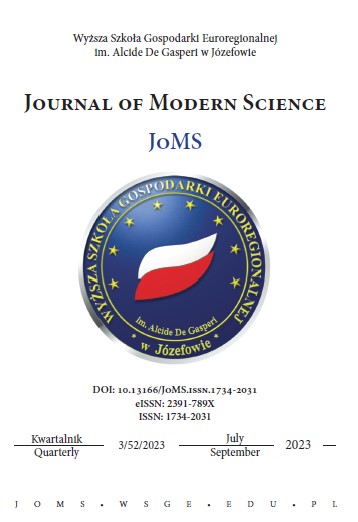THE MEDIATING ROLE OF SPIRITUAL ENGAGEMENT IN THE RELATIONSHIP BETWEEN RELIGIOSITY AND RELIGIOUS COPING. CROSS-SECTIONAL STUDY AMONG POLISH STUDENTS
THE MEDIATING ROLE OF SPIRITUAL ENGAGEMENT IN THE RELATIONSHIP BETWEEN RELIGIOSITY AND RELIGIOUS COPING. CROSS-SECTIONAL STUDY AMONG POLISH STUDENTS
Author(s): Barbara Ślusarska, Alina Deluga, Krzysztof Jurek, Grzegorz józef Nowicki, Iwona NiewiadomskaSubject(s): Higher Education , Sociology of Education, Sociology of Religion
Published by: Wydawnictwo Akademii Nauk Stosowanych WSGE im. A. De Gasperi w Józefowie
Keywords: spiritual attitudes; spirituality; spiritual engagement; stress; religious coping; Poland;
Summary/Abstract: The coping with stress is an important skill that is vital to human functioning. Spirituality and Religiosity are also determinant factors in the life decisions, experiences, and behavior of young people, which help them take on positive or negative coping strategies in the face of stressors. The aim of this study was to determine how spiritual engagement may mediate the relationship between an individual’s religiosity and their use of religious coping strategies. A total of 342 students from two universities in eastern Poland participated in the study. The average age was 20.85 [95% CI: 20.607-21.095] years old. In the study group, 87.3% of respondents admitted to being Roman Catholic, while in declarations of faith, 65.1% said they were believers, and another 13.9% considered themselves deeply religious. The data were collected using the two standardized scales: the Brief – Religious Coping Questionnaire (Brief RCOPE) and Spiritual Attitude and Involvement List (SAIL). It was observed that positive religious coping strategies prevailed among the students surveyed. The highest-rated SAIL subscale was the Meaningfulness (4.65; 95% CI: 4.571-4.723), while the lowest was Transcendent Experience (3.28; 95% CI: 3.172-3.384). Significant positive correlations were found between the six areas of spirituality assessed by the SAIL scale and positive religious coping strategies. The results showed a significant total effect of religiosity on positive religious coping (beta=0,755; B=7.665;p<0.001; 95% CI: 6.30; 8.40).The direct effect of religiosity on positive religious coping was significant (beta=0,562; B=5.706; p<0.001; 95% CI: 4.85; 6.56). The effect of religiosity on positive religious coping was partially mediated by Transcendent Experiences and Spiritual Activities. The total indirect effect was 0.193 (95% CI: 0.125; 0.265). The results showed that transcendental experiences and spiritual activity were mediators in the relationship between religiosity and positive religious stress coping strategies. The mediations were partial. The introducing aspects of spirituality and religiosity into higher education programs can help students of both medical and non-medical faculties to respond to the many difficult situations of daily life and move forward with a sense of achieving their designated tasks and goals.
Journal: Journal of Modern Science
- Issue Year: 52/2023
- Issue No: 3
- Page Range: 634-669
- Page Count: 36
- Language: English

